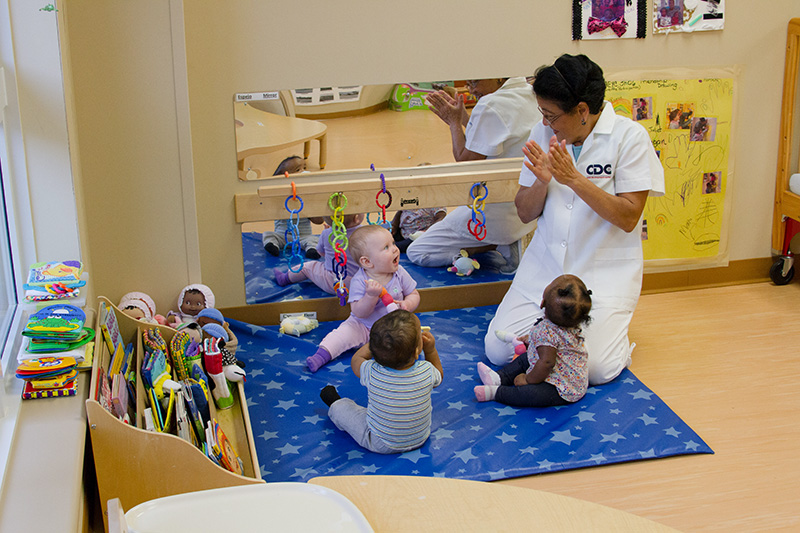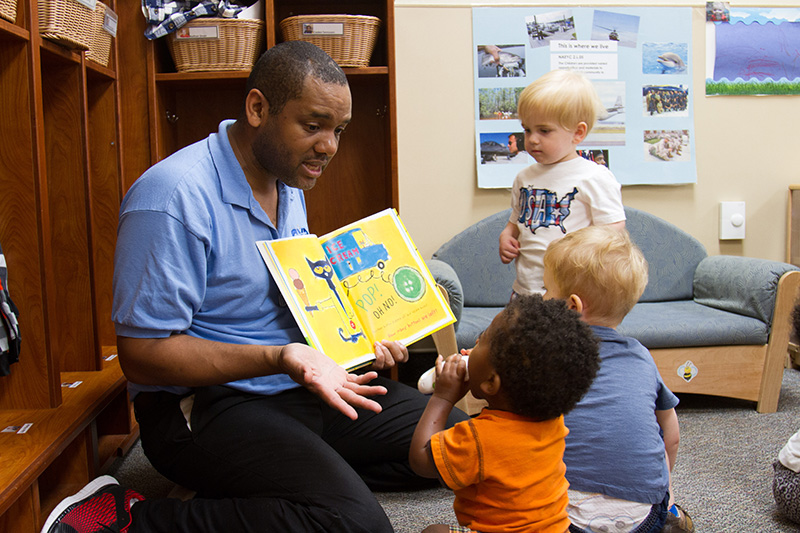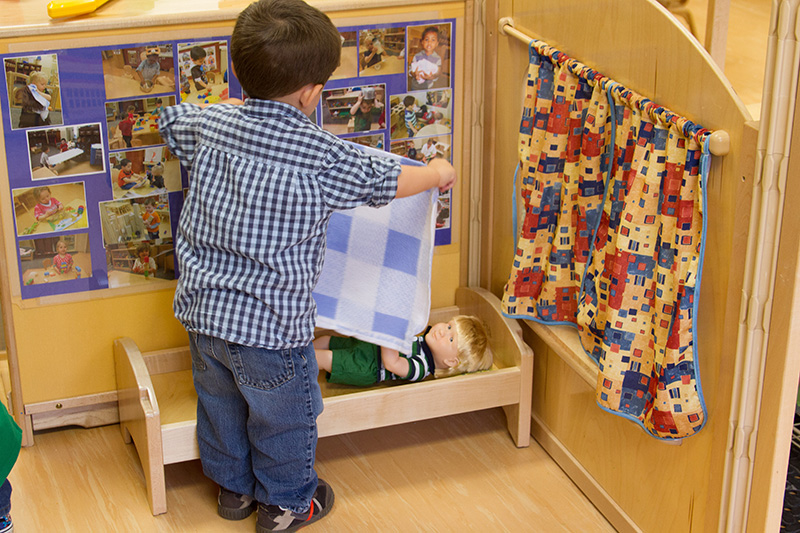- Describe behaviors that are typical for infants and toddlers.
- Identify developmental and emotional needs of infants and toddlers, including an understanding of temperament.
- Discuss the role adults can play when it comes to guidance of infants and toddlers.
Learn
Know
Think for a moment and try to identify another person in the world who is exactly like you in appearance, temperament, strengths, work role, needs, hobbies, etc.? It is unlikely that you could think of someone because you are unique, just like the infants and toddlers in your care.
The pace of development for every infant and toddler will vary across developmental domains. Domains are areas of development like physical, cognitive (intellectual), and social-emotional. Some young children will, for example, learn their colors very early in life but take much longer to develop social skills such as taking turns with other young children.
Some differences between infants or toddlers are more predictable than others. Understanding these differences and what generally might be expected at different ages can help you, as a caregiver, better understand young children. By recognizing and understanding their developmental stages, you can provide supportive guidance and create an engaging environment to develop the whole child. Using observations of each child in your care, you can determine if you must adapt your routines, environment, and activities to meet both individual and whole group needs. Staying curious about the infants and toddlers in your care and planning according to what you learn may help minimize any potentially challenging behaviors.
What Behaviors are Typical for Each Age Group?
In each domain of development, there are certain behaviors that are typical of young children during specific developmental stages. These behaviors often challenge caregivers, but they are to be expected. Consider the examples in the table below and begin thinking about how you can respond appropriately to these behaviors:
| Age Group (approximate) | Behaviors that are developmentally appropriate (or expected) but may challenge adults |
|---|---|
Pre-mobile infants (birth – 6 months) |
|
Mobile infants (7 – 12 months) |
|
Toddlers (13 – 36 months) |
|
Infant and Toddler Development
Curiosity, exploration, and discovery are aspects of infant and toddler development that take place as they interact with and learn more about the world around them. This exploration and discovery can look like challenging behavior or “misbehavior” as infants and toddlers put objects in their mouths, practice cause and effect by pushing objects (including peers), disregard verbal requests to stay focused, and even bite others to see what might happen next. By understanding infant and toddler development, in addition to the values, beliefs, and expectations for the young children and families you support, you can better predict and understand behaviors you might observe and experience.
Infants, for example, learn to trust their adult caregivers as they establish the secure attachment that is so important for ongoing relationship building, social development, and overall learning. To feel safe and to develop trust with caregivers, infants must receive responsive interactions and care from nurturing adults. As infants become mobile and begin to move about their environment more independently, caregivers can help create a space that minimizes “no” and offers the opportunity to safely explore, investigate, and discover.
Toddlers are capable of and want to do more things by themselves, such as walking, talking, getting dressed, etc. Toddlers have strong emotions about their experiences, but they do not yet have control over these emotions, which can result in tantrums. Clear, simple guidelines or limits can help teach toddlers to control their impulses and emotions over time. Try incorporating “first, then” statements. An example of this would be “First we’ll change your diaper, and then we will play with the ball.” This type of communication eliminates surprises and allows children to understand what will happen next, or what needs to happen to get to a preferred activity.
As an infant and toddler caregiver, you can expect young children to become upset when a peer has a toy they want or when it is time to come inside from fun outdoor experiences. All infants and toddlers will have moments of frustration, disappointment, and unhappiness. However, with support and guidance from nurturing adult caregivers, infants and toddlers build the capacity to regulate their emotions and to find ways to continue to engage with peers and the environment. This development depends greatly on early relationship building and it is influenced by a child's individual temperament.
Thinking About Temperament
It is important to remember that every infant and toddler is born with their own way of approaching the world; this is called temperament. Some young children, for example, are constantly on the move while others prefer to sit and watch the world around them. Some children enjoy new experiences and meeting new people while others are slower to warm-up in unfamiliar situations and may need reassurance from their caregivers.
Each infant is born with a unique temperament style. There is no right or wrong, good, or bad, temperament. By understanding temperament, you can use what you know about an infant or toddler to adjust your expectations and maintain flexibility in how and when you respond and provide guidance to help meet an infant’s or toddler’s needs.
If you find yourself becoming impatient or having a difficult time responding positively and providing supportive guidance to an infant or toddler in your care, you can engage in thoughtful discussions with your administrator. You can also learn more about temperament within the Social Emotional Development course.
Knowing more about temperament can help you plan for and interpret young children’s behaviors and provide the opportunity to support self-regulation, more effective communication, and relationship development.
Respecting Differences and Guiding Behavior
There is no one guidance approach, or strategy, that fits all infants and toddlers; each young child is unique. This requires that you continue to examine young children’s temperaments, skills, needs, strengths, and backgrounds before considering a particular guidance approach. However, in addition to recognizing, accepting, and responding to infants’ and toddlers’ emotions and behaviors, a customized guidance approach can help you support the development of skills, such as self-regulation, that will continue to develop over a lifetime. Below is a chart that lists possible guidance strategies specific to supporting infants and toddlers:
Young Infants

- Review or observe the physical surroundings in which infants play and interact to ensure safety of the environment.
- Engage in one-on-one play or conversation—take the infant’s lead and follow their interests.
- Introduce turn-taking games like rolling a ball back and forth or peekaboo.
- Use simple words and signs to help express young infants’ needs.
- Maintain a consistent, predictable schedule involving responsive routines.
Mobile Infants

- Keep expectations reasonable—older infants and toddlers are striving for independence, are egocentric, and have difficulty expressing themselves.
- Model empathy for infants to imitate.
- Use a calm tone and make positive statements as you talk with infants about the ways you are keeping them safe.
- Use simple words and signs to help them express their needs.
- Maintain a consistent, predictable schedule involving responsive routines.
- Offer two choices to infants, such as choosing between two activities or walking or being carried to the diaper-changing table.
Toddlers

- Appreciate and encourage prosocial behavior.
- Provide acceptable alternatives to behaviors.
- Teach feeling words to help toddlers express strong emotions.
- Use redirection, distraction and active listening with toddlers who say, “No” or are having trouble cooperating.
- Use simple words and demonstrations to explain limits.
- Use positive wording and language with toddlers, for example, “Please walk,” as opposed to “Don’t run.”
- Begin to offer supports for negotiating materials and ideas, e.g., “I would like to use the truck in 5 minutes” or “Can I be next?”
Responding to Challenging Behavior
One way to think about the behavior of infants and toddlers is to think about behavior as a message; it is a form of communication that has meaning. Behaviors that are considered challenging are often those in which infants and toddlers are expressing a strong reaction or little reaction to experiences. While the behavior may be quite typical for the developmental stage—for example, tantrums and biting from a toddler—it is the intensity, frequency, or duration of the behavior that causes it to be viewed as challenging. A challenging behavior can be thought of as an ongoing behavior that affects an infant’s or toddler’s ability to form and sustain relationships and build new skills.
Another way to think about challenging behavior is to picture an iceberg in your mind. The challenging behavior is the part above the water, the tip of the iceberg. The tip of the iceberg relates to behaviors infants and toddlers use when they are unable to:
- Form close and secure relationships
- Experience, regulate, and express emotions in healthy ways
- Feel safe to explore the environment and learn
- Understand expectations
Remember, the tip of the iceberg is the smallest part. The largest part of the iceberg is the part you cannot see. This area represents potential needs that are not being met or skills that need to be supported and developed. Challenging behaviors can be difficult to see and understand, and there are many needs of infants and toddlers to consider, such as:
- Sense of safety, including emotional safety
- Nurturing, responsive, consistent relationships with trusting adults
- Engaging and stimulating environments
- Understanding and responsiveness to temperament by the caregiver
- Consistent and predictable routines
- Good health (adequate sleep, nutrition)
- Opportunities for movement
- Sense of belonging within family, community, and child care
Keep the concept of the iceberg in mind in order to support your efforts to understand the meaning of a young child’s challenging behavior, which is the first step to finding an appropriate and supportive response. Because behavior is a form of communication, your understanding of the meaning of the behavior will help you develop strategies to help meet a young child’s needs and support the development of new skills. As an infant and toddler caregiver, your first reaction to a challenging behavior should be to consider the underlying reason for the behavior, or the largest part of the iceberg, and to think about what changes to your environment, activities, or response you can make to help the child work through the behavior.
Remember that infants and toddlers are trying to communicate a message with each behavior (even the challenging ones); they are trying to tell us what it is like to be them and what it feels like in their world.
Challenging Behavior – In the Eye of the Beholder
As an infant and toddler caregiver, you should recognize that your understanding of and values regarding behavior may be different from those of others you work with and the families of the young children you care for. Some behaviors that you find challenging may be viewed as acceptable and desirable within the young child’s family. For example, an infant in your care may not make eye contact with you during daily routines and interactions. In some families, eye contact can be viewed as disrespectful and therefore, it is not promoted during interactions. Another example could be that you might feel concerned about a toddler who is quiet, does not express needs and wants, and spends most of their time watching other children play. When you reach out to the family of the child, you may learn that children in their family are taught to learn through quiet observations and listening to adults, and that the toddler’s quiet nature is viewed by the family as being a “respectful” child.
Reflecting on the ways you respond to certain behaviors can help you uncover your thoughts about these behaviors. Remember that what you think impacts what you do!
See
Guiding Infant and Toddler Behavior: Developmental Skills and Considerations
Infant and Toddler Behavior: Preventing, Understanding and Guiding
Do
You can continue to provide guidance by responding to infants’ and toddlers’ behaviors in many ways:
- Acknowledge the infant’s or toddler’s emotions. Say, “You seem sad,” or, “You look very upset.”
- Change the holding position of an infant and say, “You do not seem comfortable, let me try to hold you closer. I will help you feel better.”
- Use words that help narrate what you think an infant or toddler might be wanting. “You seem frustrated. You really wanted to play with those bubbles. Should we find more?”
- Keep temperament in mind as you continue to make sense of different experiences for infants and toddlers.
- Help an infant or toddler achieve the understood intention. “When you want more milk, you can point to your sippy cup” or help say and demonstrate the sign for milk to support their communication and requests to meet their needs.
Explore
Reflect on the ways you respond to challenging behavior as you complete the Considering Behavior activity. Then, share and discuss your responses with a trainer, coach, or administrator.
Apply
Reflect on the resources included in Learning More About Infant and Toddler Behavior. You can use these resources to explore and better understand guidance and a relationship-based approach to responding to challenging behavior.
In addition, you can use the resources in Recommended Practices: Supporting Infants and Toddlers with Challenging Behavior, Understanding and Managing Children's Behaviors, and Addressing Challenging Behavior in Infants and Toddlers to help inform the way you support infants and toddlers with challenging behaviors.
Glossary
Demonstrate
Adams, S. K. (2005). Promoting positive behavior: Guidance strategies for early childhood settings. Pearson Merrill Prentice Hall.
Bronson, M. B. (2001). Self-regulation in early childhood. Nature and nurture. Guilford.
Landy, S. (2009). Pathways to competence: Encouraging healthy social and emotional development in young children (2nd ed.). Brookes Publishing.
Parlakian, R. (2002). Building strong foundations: Practical guidance for promoting the social/emotional development of infants and toddlers. Zero to Three.
Sameroff, A. J., McDonough, S. C., & Rosenblum, K. L. (2005). Treating parent-infant relationship problems: Strategies for intervention (1st ed.). Guilford Press.


